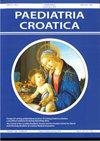11岁女孩Schimke免疫-骨发育不良的神经症状:1例报告
Q4 Medicine
引用次数: 1
摘要
背景:Schimke免疫-骨发育不良(SIOD, OMIM 242900)是一种罕见的常染色体隐性多益性疾病,由SMARCAL1基因突变引起。SIOD的特征是三种症状,即由局灶节段性肾小球硬化(FSGS)引起的进行性肾脏疾病、脊柱骨骺发育不良和t细胞免疫缺陷。此外,在该综合征的病程中经常观察到异质神经症状。病例:作者描述了一个14岁的SIOD女孩的病例,她表现出复发性神经系统症状,如偏头痛样头痛,复视和癫痫发作。她在怀孕34周时出生,体重不足(1280克),身材矮小(44厘米)。肾脏范围蛋白尿是该病的第一个症状,在4岁半时被发现。还观察到明显的免疫缺陷。由于在SMARCAL1基因中发现了C . 836t >C (p.F279S)和C . 2542g >T (p.E848X)两个部分基因变异,最终诊断为Schimke免疫-骨发育不良。结论:本报告描述了一例SIOD患者的临床特征和神经影像学表现。它还提出了神经事件与Schimke病之间可能的相关性,这在诊断过程中应予以考虑。本文章由计算机程序翻译,如有差异,请以英文原文为准。
Neurological symptoms in Schimke immuno-osseous dysplasia in a 11-year-old girl: a case report
Background: Schimke immuno-osseous dysplasia (SIOD, OMIM 242900) is a rare, autosomal recessive, pleiotropic disease caused by mutations in the SMARCAL1 gene. SIOD is characterized by a triad of symptoms, i.e., progressive kidney disease due to focal segmen- tal glomerulosclerosis (FSGS), spondyloepiphyseal dysplasia and T-cell immunodeficiency. Additionally, heterogeneous neurological symptoms are often observed in the course of the syndrome. Case: The authors describe the case of a 14-year-old girl with SIOD, who presented with recurrent neurological symptoms, such as migraine-like headaches, diplopia and seizures. She was born at 34 weeks of pregnancy with hypotrophy (1280 g) and short stature (44 cm). Nephrotic-range proteinuria, the first symptom of the disease, was detected at the age of 4 and a half years. Significant immunodeficiency was also observed. She was finally diagnosed with Schimke immuno-osseous dysplasia on account of two pat- hogenic variants, c.836T>C (p.F279S) and c.2542G>T (p.E848X) identified in the SMARCAL1 gene. Conclusions: This report describes the clinical features and neuroimaging findings of a patient with SIOD. It also presents a possible correlation between neurological events and the Schimke disease, which should be considered during the diagnostic process.
求助全文
通过发布文献求助,成功后即可免费获取论文全文。
去求助
来源期刊

Paediatria Croatica
医学-小儿科
CiteScore
0.20
自引率
0.00%
发文量
0
审稿时长
6-12 weeks
期刊介绍:
In the inaugural 1956 issue of the journal, the editor Dr Feđa Fischer Sartorius outlined the journal''s vision and objectives saying that the journal will publish original papers on the development, pathology, and health care of children from the prenatal period to their final biological, emotional and social maturity. The journal continues this vision by publishing original research articles, clinical and laboratory observations, case reports and reviews of medical progress in pediatrics and child health.
 求助内容:
求助内容: 应助结果提醒方式:
应助结果提醒方式:


